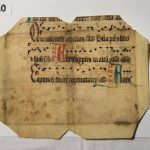The fragment has been written in a 15th-century Hungarian traditionalist notation, most probably developed by the Pauline fathers. The neume set is incomplete: there is no climacus, which could be conclusive regarding the Pauline origin. The fragment’s Pauline provenance is suggested by (1) other neume forms (pes, clivis, torculus), which are carefully conjunct despite the Gothic pen treatment – they are all written without lifting the pen –, (2) the difference in size between the basic neume, as bigger and smaller punctum can also be documented, similarly to other Pauline sources (e.g. from the Częstochowa Cantuale, see Gabriella Gilányi, “The musical notation of the Czestochowa Cantuale”, https://doi.org/10.23714/rzt.fragmenta.publ.1004). In our fragment, the contrast between the use of the punctum, i.e. the execution of the syllabic puncta and the puncta in neumes, recorded with two different pen thicknesses, is particularly sharp. The clivis and the torculus are reminiscent of the old Esztergom form, while the notator depicts the neume elements in one process of movement, with lines, rather than as separate notes. Our comparative study has also recently shown that the layout, defined by the difference between the rhombic note heads and the traditional conjunct forms, was mainly characteristic of the Pauline script of the periphery in the 15th and 16th centuries. This is supported by a number of source examples from Upper Hungary, Transylvania and Zagreb (see Gabriella Gilányi, “Preservation and Creation. Plainchant notation of the Pauline Order in 14th-18th-century Hungary”, Studia Musicologica 59, 2018/3-4: 399–417). This is probably not the work of the Pauline mother monastery of Budaszentlőrinc, which might be confirmed by the owner of the host book, the monastery of St. Helen of Csáktornya in today Croatian territory: it could be a Southern Pauline scriptorium. László Mezey obviously deduced the Pauline origin of the fragment from its former owner (see Bibliography). A review of the musical palaeography supports this view.
An analysis of the liturgical content also confirms, though not substantially adds to, the above: the order of Ascensio chants shown here is identical with the Esztergom and Pauline versions (see e.g. Pauline Antiphoner, Zagreb, Metropolitanska knjižnica, MR 8). After a few antiphons of the Lauds, the verso folio contains the movements of the Prima, Tertia and Sexta: not only the chants, but also the melodies fit into the central Hungarian tradition.
Gabriella Gilányi



